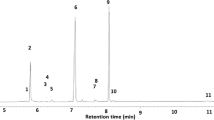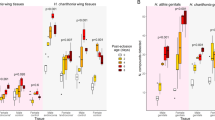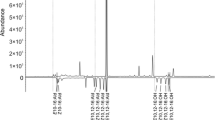Abstract
Males of the Caribbean fruit fly,Anastrepha suspensa (Loew), typically form leks and attract females by releasing a multicomponent volatile pheromone. Previous reports have identified two nine-carbon alcohols, three lactones, a sesquiterpene, and a monoterpene in the volatiles. The present report is a study of the physiology of male pheromone release and of ecological and social interactions that influence pheromone release by laboratoryreared flies. Volatiles released by males were trapped on Tenax, eluted, separated, and quantitatively measured by gas chromatography. Experiments showed that the volatiles were primarily released from mouth and anus. Sealing the anal opening or the mouth with melted beeswax resulted in up to 40% or greater reduction in most components, and sealing both mouth and anus further reduced release of volatiles, but some volatiles are possibly still released directly from the cuticle. An anal pouch of everted tissue played a major role as a large evaporative surface for release of some of the volatile components. Male flies entrained to a 14∶10 light-dark cycle showed a peak release of volatiles at 11–12 hr into the photophase, but smaller quantities of the same volatiles were released over a broad period during the daylight hours. Laboratory-reared males peaked in pheromone release at 7–10 days and production and release continued through 35 days of age. Single males released significantly more of all components measured than did groups of males. The reduction by aggregations of males may be related to lekking behavior in this fruit fly. The pheromone probably serves to attract females to a lek site, but additional parameters are likely to enter into the choice of male made by the arriving female.
Similar content being viewed by others
References
Alexander, R.D. 1975. Natural selection and specialized chorusing behavior in acoustical insects, pp. 35–75,in D. Pimentel (ed.). Insects, Science & Society. Academic Press, New York.
Battiste, M.A., Strekowski, A., Vanderbilt, D.P., Visnick, M., King, R.W., andNation, J.L. 1983. Anastrephin and epianastrephin, novel lactone components isolated from the sex pheromone blend of male Caribbean and Mexican fruit flies.Tetrahedron Lett. 24:2611–2614.
Bradbury, J.W. 1981. The evolution of leks, pp. 138–169,in R. Alexander and D. Tinkle (eds.). Natural Selection and Social Behavior. Chiron Press, Oxford, UK.
Burk, T. 1981. Signaling and sex in acalyptrate flies.Fla. Entomol. 64:30–43.
Burk, T. 1983. Behavioral ecology of mating in the Caribbean fruit fly,Anastrepha suspensa (Loew) (Diptera: Tephritidae).Fla. Entomol. 66:330–344.
Burk, T. 1984. Male-male interactions in Caribbean fruitflies,Anastrepha suspensa (Loew) (Diptera: Tephritidae): Territorial fights and signalling stimulation.Fla. Entomol. 67:542–548.
Burk, T., andWebb, J.C. 1983. Effect of male size on calling propensity, song parameters, and mating success in Caribbean fruit flies,Anastrepha suspensa (Loew) (Diptera: Tephritidae).Ann. Entomol. Soc. Am. 76:678–682.
Chambers, D.L., Cunningham, R.T., Lichty, R.W., andThrailkill, R.B. 1974. Pest Control by attractants: A case study demonstrating economy, specificity, and environmental acceptability.BioScience 24:150–152.
Cross, J.H. 1980. A vapor collection and thermal desorption method to measure semiochemical release rates from controlled release formulations.J. Chem. Ecol. 6:781–787.
Chuman, T., Sivinski, J., Heath, R.R., Calkins, C.O., Tumlinson, J.H., Battiste, M.A., Wydra, R.L., Strekowski, L., andNation, J.L. 1988. Suspensolide, a new macrolide component of male Caribbean fruit fly [Anastrepha suspensa (Lowe)] volatiles.Tetrahedron Lett. 29(50):6561–6564.
Dodson, G.N. 1982. Mating and territoriality in wildAnastrepha suspensa (Diptera: Tephritidae) in field cages.J. Ga. Entomol. Soc. 17:189–200.
Dodson, G. 1986. Lek mating system and large male aggressive advantage in a gall-forming tephritid fly (Diptera: Tephritidae).Ethology 72:99–108.
Emlen, S.T., andOring, L.W. 1977. Ecology, sexual selection, and the evolution of mating systems.Science 197:215–223.
Feron, M. 1959. Attraction chimique du mâle deCeratitis capitata Wied (Dipt. Trypetidae) pour la femelle.C.R. Acad. Sci. Paris 248:2403–2404.
Golub, M.A., andWeatherston, I. 1984. Techniques for extracting and collecting sex pheromones from live insects and from artificial sources, pp. 223–285,in H.E. Hummel and T.A. Miller (eds.). Techniques in Pheromone Research. Springer-Verlag, New York.
Greany, P.D., Ashley, T.R., Baranowski, R.M., andChambers, D.L. 1976. Rearing and life history studies onBiosteres (Opius) longicaudatus.Entomophaga 21:207–215.
Hendrichs, J.P. 1986. Sexual selection in wild and sterile Caribbean fruit flies,Anastrepha suspensa (Loew) (Diptera: Tephritidae). MS thesis. University of Florida, Gainesville, Florida.
Kuba, H., Koyama, J. andProkopy, R.J. 1984. Mating behavior of wild melon flies,Dacus cucurbitae Coquillett (Diptera: Tephritidae) in a field cage: Distribution and behavior of flies.Appl. Entomol. Zool. 19:367–373.
Lhoste, J., andRoche, A. 1960. Organes odoriferants des mâles deCeratitis capitata.Bull. Soc. Entomol. Fr. 65:206–210.
Malavasi, A., Morgante, J.S., andProkopy, R.J. 1983. Distribution and activities ofAnastrepha fraterculus (Diptera: Tephritidae) flies on host and nonhost trees.Ann. Entomol. Soc. Am. 76:286–292.
McDonald, P.T. 1987. Intragroup stimulation of pheromone release by male Mediterranean fruit flies (Diptera: Tephritidae).Ann. Entomol. Soc. Am. 80(1):17–20.
Morgante, J.S., Malavasi, A., andProkopy, R.J. 1983. Mating behavior of wildAnastrepha fraterculus (Diptera: Tephritidae) on a caged host tree.Fla. Entomol. 66:234–241.
Nation, J.L. 1972. Courtship behavior and evidence for a sex attractant in male Caribbean fruit fly,Anastrepha suspensa.Ann. Entomol. Soc. Am. 65:1364–1367.
Nation, J.L. 1974. The structure and development of two sex specific glands in male Caribbean fruit flies.Ann. Entomol. Soc. Am. 67(5):731–734.
Nation, J.L. 1975. The sex pheromone blend of Caribbean fruit fly males: Isolation, biological activity, and partial chemical characterization.Environ. Entomol. 4(1):27–30.
Nation, J.L. 1981. Sex-specific glands in tephritid fruit flies of the generaAnastrepha, Ceratitis, Dacus andRhagoletis (Diptera: Tephritidae).Int. J. Insect Morphol. Embryol. 10:121–129.
Nation, J.L. 1983. Sex pheromone of the Caribbean fruit fly: Chemistry and field ecology, pp. 109–110,in J. Miyamoto and P.C. Kearney (eds.). IUPAC Pesticide Chemistry, Human Welfare and the Environment. Pergamon Press, New York.
Nation, J.L. 1989. The role of pheromones in the mating system ofAnastrepha fruit flies, pp. 189–205,in A.S. Robinson and G. Hooper (eds.). Fruit Flies, Their Biology, Natural Enemies and Control, Vol. 3A. Elsevier, Amsterdam.
Perdomo, A.J. 1974. Sex and aggregation pheromone bioassays and mating observations of the Caribbean fruit fly,Anastrepha suspensa (Loew), under Field Conditions. PhD dissertation. University of Florida, Gainesville, Florida.
Perdomo, A.J., Baranowski, R.M., andNation, J.L. 1975. Recapture of virgin female Caribbean fruit flies from traps baited with males.Fla. Entomol. 58:291–295.
Perdomo, A.J., Nation, J.L., andBaranowski, R.M. 1976. Attraction of female and male Caribbean fruit flies to food-baited and male-baited traps under field conditions.Environ. Entomol. 5:1208–1210.
Pritchard, G. 1967. Laboratory observations on the mating behavior of the island fruit flyRioxa pornia (Diptera: Tephritidae).J. Aust. Entomol. Soc. 6:127–132.
Prokopy, R.J., andHendrichs, J. 1979. Mating behavior ofCeratitis capitata on a field-caged host tree.Ann. Entomol. Soc. Am. 72:642–648.
Prokopy, R.J., andRoitberg, B.D. 1984. Foraging behavior of true fruit flies.Am. Sci. 72:41–49.
Robacker, D.C., andHart, W.G. 1985a. Courtship and territoriality of laboratory reared Mexican fruit flies,Anastrepha ludens (Diptera: Tephritidae), in cages containing host and nonhost trees.Ann. Entomol. Soc. Am. 78:488–494.
Robacker, D.C., andHart, W.G. 1985b. (Z)-3-Nonenol, (Z,Z)-3,6-nonadienol and (S,S)-(−)-epianastrephin: Male-produced pheromones of the Mexican fruit fly.Entomol. Exp. Appl. 39:103–108.
Sivinski, J. 1984. Effect of sexual experience on male mating success in a lek forming tephritidAnastrepha suspensa (Loew).Fla. Entomol. 67:126–130.
Sivinski, J., andBurk, T. 1989. Reproductive and mating behavior, pp. 343–351,in A.S. Robinson and G. Hooper (eds.). Fruit Flies, Their Biology, Natural Enemies and Control, Vol. 3A. Elsevier, Amsterdam.
Spieth, H.T. 1970. Biology and behavior in the evolutionary biology of the Hawaiian Drosophilidae, pp. 469–489,in M.K. Hecht and W.C. Steere (eds.). Essays in Evolution and Genetics in Honor of Theodosius Dobzhansky. Appleton-Century-Crofts, New York.
Thornhill, R. 1980. Competitive, charming males, and choosy females: Was Darwin correct?Fla. Entomol. 63:5–30.
Thornhill, R., andAlcock, J. 1983. The Evolution of Insect Mating Systems. Harvard University Press, Cambridge, Massachusetts.
Thornhill, R., Dodson, G., andMarshall, L. 1983. Sexual selection and insect mating behavior.Am. Biol. Teacher. 45:310–319.
Tychsen, P.H. 1977. Mating behavior of the Queensland fruit fly,Dacus tryoni (Diptera: Tephritidae), in field cages.J. Aust. Entomol. Soc. 16:459–465.
Webb, J.C., Sharp, J.L., Chambers, D.L., McDow, J.J., andBenner, J.C. 1976. The analysis and identification of sounds produced by the male Caribbean fruit fly,Anastrepha suspensa (Loew).Ann. Entomol. Soc. Am. 69:415–420.
Webb, J.C., Burk, T., andSivinski, J. 1983. Attraction of female Caribbean fruit flies,Anastrepha suspensa (Diptera: Tephritidae), to the presence of males and male-produced stimuli in field cages.Ann. Entomol. Soc. Am. 76:996–998.
Webb, J.C., Sivinski, J., andLitzkow, C. 1984. Acoustical behavior and sexual success in the Caribbean fruit fly,Anastrepha suspensa (Loew) (Diptera: Tephritidae).Environ. Entomol. 13:650–656.
Willis, M.A., andBirch, M.C. 1982. Male lek formation and female calling in a population of the arctiid mothEstigmene acrea.Science 218:167–170.
Author information
Authors and Affiliations
Additional information
This is University of Florida Agricultural Experiment Station Journal Series No. 9589.
Rights and permissions
About this article
Cite this article
Nation, J.L. Biology of pheromone release by male caribbean fruit flies,Anastrepha suspensa (Diptera: Tephritidae). J Chem Ecol 16, 553–572 (1990). https://doi.org/10.1007/BF01021786
Received:
Accepted:
Issue Date:
DOI: https://doi.org/10.1007/BF01021786




